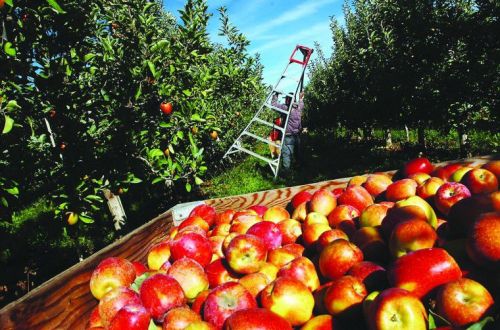Fruit growers aim toward sustainability
Published 4:59 am Friday, April 29, 2011

- A worker moves his ladder while harvesting braeburn apples for Earl Brown and Sons on last October outside Milton-Freewater.
MILTON-FREEWATER In the past 20 years, fruit growers in the Milton-Freewater area have been moving toward a more sustainable operation.
While endeavoring harm the environment less, growers have been working to increase their trees per acre and protect fruit from extreme temperatures.
One example is how farmers deal with some pests, said Dennis Burks, a crop consultant for Blue Mountain Growers of Milton-Freewater.
Codling moths larvae are the proverbial worm in the apple. They can bore into apples and eat the seedy cavity.
In the past, growers used pesticides to take care of this pest, but Burks said there is a simpler way. Now growers disrupt the moths mating season by hanging pheromones in a tree. This keeps the moths from mating, from laying eggs and producing larvae.
Farmers have learned how to more efficiently arrange their orchards to accommodate more trees per acre. In the past an orchard may have fit about 100 trees per acre. Now theyre fitting 1,210 trees per acre, Burks said.
Temperature control always is a challenge for fruit growers. Cold temperatures could harm flowers or fruit, and high temperatures can sunburn fruit.
Growers once used smudge pots fueled heaters to warm orchards during freezes. Today, orchards use a combination of watering and small wind turbines to warm the air and move it around an orchard.
When temperatures dip below freezing, a grower can water the base of a tree. When the water freezes, it produces latent heat that rises to warm the rest of the tree. Then the grower switches on the wind machines to move the warm air around.
In the summer, growers can cool trees from above with sprinkler systems once temperatures rise above 90 degrees.
With high temperatures and clear skies, the heat can damage apples. Sunburn looks like white, tan or yellow patches on the fruit. Those patches can turn brown after a few weeks in cold storage.
Burks uses a special sunburn protection for the apples, called Eclipse. Its a combination of boron and calcium carbonate. It is sprayed on the surface, making the apples look white. Like sunblock on human skin, the white layer protects the apple from those harmful rays.
Many of these problems pests, cold, sunburn were things growers just dealt with in the past, Burks said. But with improving technology and techniques, farmers are able to increase their yields.





